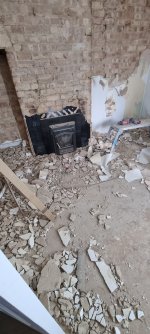Throwgnilli
New Member
Hi,
I have a Chimney Breast with no liner on the flue and sealed with a cast iron inset fire.
It must have been intalled for 10 years and before I hacked off all the plaster and render I saw that it had cracked.
I can find alot of information about rendering the insides of a fireplace when a log burner is installed, but nothing on what to do on the breast around an inset fireplace.
Is there anything fancy I need to do? I am dotting and dabbing the rest of the room and unsure what to do around the breast.
If there is some sand and cement rendering to be done or vitcas, what's the best way to blend it in to the dot and dabbed sections?
cheers
I have a Chimney Breast with no liner on the flue and sealed with a cast iron inset fire.
It must have been intalled for 10 years and before I hacked off all the plaster and render I saw that it had cracked.
I can find alot of information about rendering the insides of a fireplace when a log burner is installed, but nothing on what to do on the breast around an inset fireplace.
Is there anything fancy I need to do? I am dotting and dabbing the rest of the room and unsure what to do around the breast.
If there is some sand and cement rendering to be done or vitcas, what's the best way to blend it in to the dot and dabbed sections?
cheers
Attachments
Last edited:


